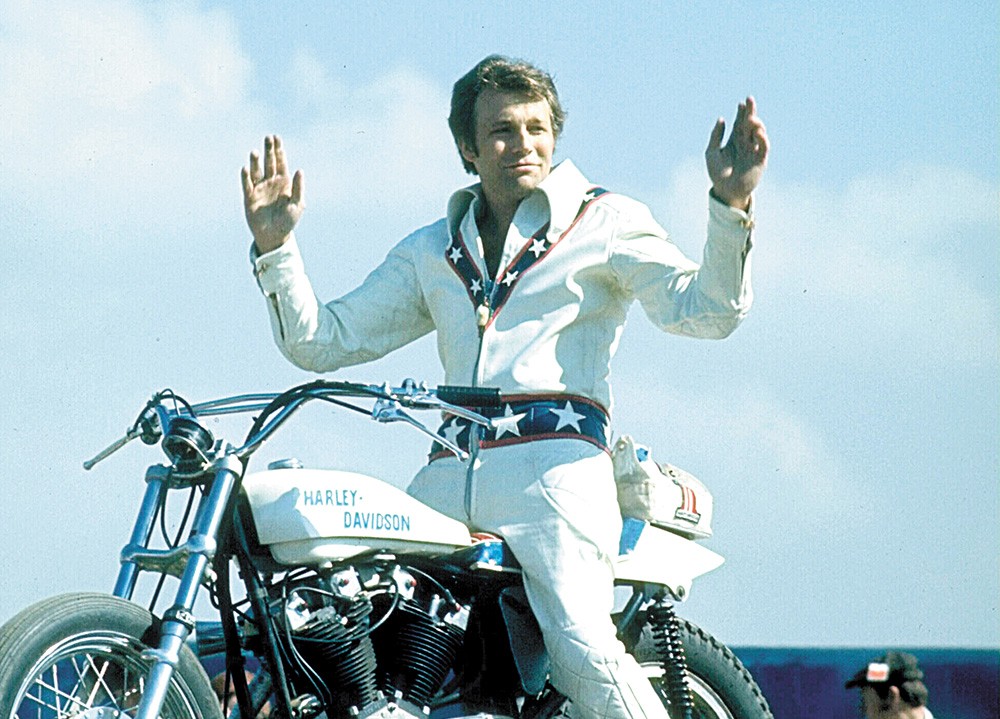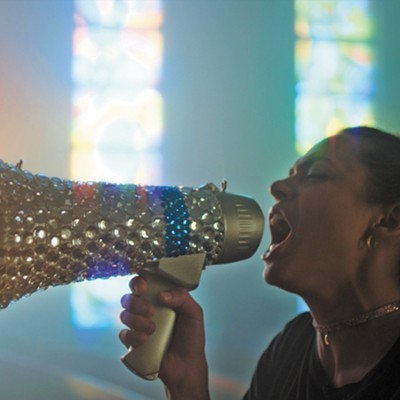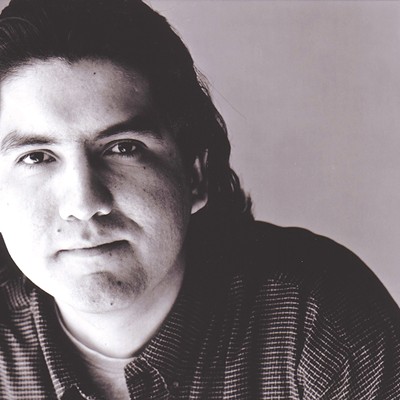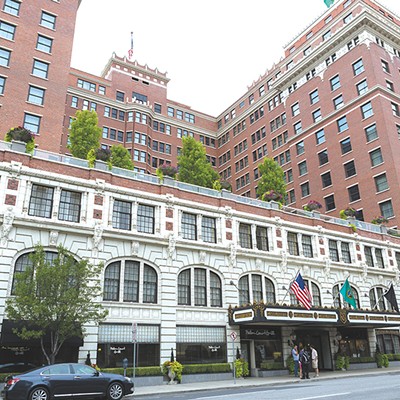Evel Knievel, this planet's most celebrated motorcycle daredevil, who inspired a generation of boys to climb upon their own two-wheelers and damn near kill themselves, died last month at the age of 69.
Knievel was laid to rest in Butte on Monday following a massive public send-off officiated by — of all people — the Rev. Robert Schuller, founder of the Crystal Cathedral megachurch of Orange County.
If you didn't quite get that last bit to square up in your brain, you're not alone. Yet, apparently, it's true. Just last April, Evel proclaimed himself born again.
I confess that I was more disappointed by this news than I was (as a kid) about Knievel's disastrous Snake River Canyon jump in 1974. Where, in his final days, was the man who once laughed at fear, defied nature's physical laws and taunted death? Where was the swaggering, boasting master risk-taker whose records for spans jumped and bones shattered are splashed across the pages of the Guinness Book of World Records? Missing in action. Or was he?
I sought the advice of those possessing more insight: Those who had crossed the gossamer fan/celebrity barrier to actually meet, greet and even gather signatures from this All-American legend.
One group that reputedly followed Knievel's career with the keenest of interest — as fellow daredevils and as enthusiasts of large, heavy American-made motorcycles — were the Hell's Angels. A conversation immediately after Knievel's demise with a noted West Coast Hell's Angels (whose identity I'm not at liberty to divulge) revealed a deep appreciation among club members for the raw guts and steely nerve it took to perform trick motorcycle riding — especially high-flying jumps — in the early 1960s when Knievel got his start as lead performer of "Evil Knievel and His Motorcycle Daredevils." This was long before stunt riders (like his son, Robbie, who today is following in his famous father's tire tracks) could afford to pay teams of engineers to work out every last detail of ramp design, payload, bike alteration, wind speed and aerodynamics.
"He didn't know anything about aerodynamics," the Angel laughs. "Evel would dream up those jumps on his own. He'd just throw a ramp together, jump on his bike and do it. In the early days, he didn't even use a landing ramp."
Knievel never strapped himself in, either. Nor did he use stunt bikes — stripped-down and lightened up with replacement parts for efficiency. Most of the bikes he used for jumping were burly American and British brands. And he rode them more or less "stock."
"There aren't any fancy aluminum or plastic parts on those bikes," explains the Angel. "He made those jumps with Harleys and Triumphs and Nortons. All of which are really heavy bikes. That's why we've always had a lot of respect for the guy. He was fearless."
Like millions of other impressionable kids across America in the late '60s, growing up in the shadow of the world's greatest living stuntman, Spokane resident Dave Johnson idolized Knievel. Like so many kids, he followed Knievel's exploits from the safe confines of his suburban Spokane home, watched his jumps on ABC's Wide World of Sports, kept track of how many cars he had successfully cleared, and held vigils for him whenever he'd be laid up in the hospital for weeks (sometimes months) following many a spectacular and often life-threatening crash.
Knievel's wipeouts were typically broadcast coast-to-coast on live television. Think about that for a second: Where amid the hundreds of all-digital, Super-HD channels accessible to modern eyeballs can you find that kind of heart-stopping entertainment? Knievel's breathtaking and eminently perilous motorcycle jumps had more in common with the gladiatorial combat of ancient Rome than with anything that touts itself as "dangerous" today. X-Games? Pro wrestling? Not even close.
If you want to witness real, palpable, spine-tingling danger as it was once televised during the Knievel Golden Era, run the tape of his infamous attempt over the fountains outside Caesar's Palace in Las Vegas on New Year's Eve, 1967, before a live crowd of 25,000 and dozens of live cameras. Now that was entertainment — aching, gut-wrenching, heart-breaking entertainment. Because with Knievel, it was all real. And frequently, it ended in grisly disaster. In the case of Caesar's Palace, he cleared the fountain — only to be undone by a problematic landing.
Today you can see it over and over again on YouTube — the spectacle of a human being taking the spill that almost snuffed out his life.
Johnson winces as he recalls the unforgettable imagery of his boyhood hero's body hurtling over the handlebars of his bike, landing on his head, flopping over lifelessly as a rag doll, getting run over by his own bike and finally sliding unconscious into a retaining wall. Knievel was in a coma for 29 days after that one. But when he came out of it, he discovered that the entire world — including nearly every kid in Spokane — had been keeping close tabs on his recovery. Suddenly, he was an international sensation — a Superstar. That very spring, he was back on the road, capitalizing on his newfound fame and building upon his reputation as a consummate showman.
Knievel's travels (particularly after his retirement from stunt riding in 1980) would frequently bring him into Spokane — if only to tie one on at a local drinking establishment and mingle with his fans, whom he always seemed to enjoy. Johnson had his first Spokane Knievel experience at the old Flaherty's Tavern on West Sprague in 1989.
"We recognized him instantly as he came in," relates Johnson. "He was tanked! But he was so gracious. He shook my hand and signed a napkin for me."
It was the standard Knievel fan greeting: "Happy Landings. Evel Knievel."
But the crown jewel of Johnson's Knievel memorabilia collection is the vintage Evel Knievel Aladdin steel lunch box commemorating the daredevil's fateful 1974 Snake River Canyon jump and featuring his legendary X-2 rocket-powered SkyCycle. After meeting Knievel the first time, Johnson drove around with that lunchbox wedged under the seat of his 1966 Plymouth Fury for a year and a half, hoping for another encounter. Next time, he obsessed, the lunchbox would be signed.
In 2004, the stars were once again aligned in his favor as Johnson got wind of another Spokane Knievel sighting — this time, out at the local Harley-Davidson dealership. The rest is a blur. All Johnson recalls is walking away, the Knievel-signed lunchbox in his respectful mitts.
When I told Dave Johnson about Knievel's recent conversion, Johnson looked puzzled. "Really?" he asked incredulously. "Wow. I wish you hadn't told me that."
Indeed. The last thing those of us who revered Knievel as the greatest risk-taker of this or of any other universe wanted to hear was that the incorrigible, hard-drinking, desperate-living Stunt King who had inspired all of us and millions more to reach for our own meager bicycle stunt glories had made the decision to betray his bare-knuckled heritage and his glorious devil-may care legacy for the fleeting thrills of Christianity. Why couldn't he have gone out with guns and tailpipes blazing as did another fiercely independent, freethinking, red-blooded American icon, gonzo journalist Hunter S. Thompson? (Thompson, you'll recall, was unrepentant to the end and had his ashes shot out of a very large, very loud cannon.)
It's so totally out of character, I can't help but be suspicious of his real motives. The fact is, Knievel was anything but subtle. The extremes of his personality exemplified the very best and, at times, the worst of humanity. On the positive side of the ledger, Knievel was courageous (though many would argue, foolhardy), fearless, generous, hard-working and loyal. He never discarded his past, never forgot from whence he came. In fact, Knievel took great pride in his Butte heritage, frequently mentioning his beloved hometown in interviews and before internationally televised stunts. All this is in stark contrast to his equally vibrant dark side, which was violent, quick-tempered, unscrupulous and vain. His recent conversion notwithstanding, Knievel left this world without fully resolving his lifelong struggle between the opposing forces within his nature.
As with so many things connected to King of the Daredevils, clear, concise answers are so lost in a fog of exaggeration, innuendo and mythology, that the truth may never be fully revealed. Yeah, when it comes to anecdotes about Evel Knievel, you're much better off making up your own version of the truth — and stick to it no matter what they throw at you.
That's the way Knievel himself always worked it.
And so I shall henceforth regard his 11th-hour conversion to Super-Sized Christianity as his last stunt — a typically erratic, typically Evel jump into eternity.
Happy landings, Evel. And watch out for that last bus.





















